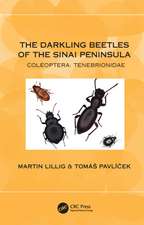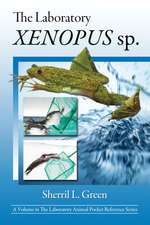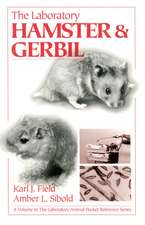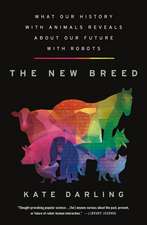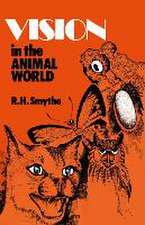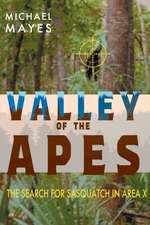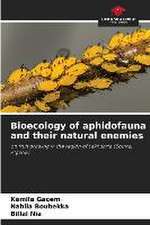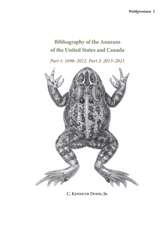Canine Olfaction Science and Law: Advances in Forensic Science, Medicine, Conservation, and Environmental Remediation
Editat de Tadeusz Jezierski, John Ensminger, L. E. Papeten Limba Engleză Hardback – 20 apr 2016
Edited and contributed to by eminent scholars, Canine Olfaction Science and Law: Advances in Forensic Science, Medicine, Conservation, and Environmental Remediation takes a systematic scientific approach to canine olfaction. It includes work from scientists working in pure and applied disciplines, trainers and handlers who have trained and deployed detection dogs, and lawyers who have evaluated evidence produced with the aid of detection and scent identification dogs.
The book is divided into six sections covering
- The anatomy, genetics, neurology, and evolution of canine olfaction as well as diseases affecting it
- The chemistry and aerodynamics of odors
- Behavior, learning, and training
- Uses of canine olfaction in forensics and law
- Uses in conservation and remediation
- Uses in detection of diseases and medical conditions
A useful practical reference, Canine Olfaction Science and Law provides a wealth of information beneficial to a wide range of disciplines. It aids trainers and handlers of detection dogs as well as various professionals in healthcare, law enforcement, forensic science, and environmental conservation to gain a better understanding of the remarkable power of the canine nose while encouraging further advances in applications.
| Toate formatele și edițiile | Preț | Express |
|---|---|---|
| Paperback (1) | 550.19 lei 6-8 săpt. | |
| Taylor & Francis – 31 mar 2021 | 550.19 lei 6-8 săpt. | |
| Hardback (1) | 927.26 lei 6-8 săpt. | |
| Taylor & Francis – 20 apr 2016 | 927.26 lei 6-8 săpt. |
Preț: 927.26 lei
Preț vechi: 1130.80 lei
-18% Nou
Puncte Express: 1391
Preț estimativ în valută:
177.49€ • 192.86$ • 149.19£
177.49€ • 192.86$ • 149.19£
Carte tipărită la comandă
Livrare economică 21 aprilie-05 mai
Preluare comenzi: 021 569.72.76
Specificații
ISBN-13: 9781482260236
ISBN-10: 1482260239
Pagini: 510
Ilustrații: 69 black & white illustrations, 32 black & white tables
Dimensiuni: 178 x 254 x 33 mm
Greutate: 3.05 kg
Ediția:1
Editura: Taylor & Francis
Colecția CRC Press
Locul publicării:Oxford, United Kingdom
ISBN-10: 1482260239
Pagini: 510
Ilustrații: 69 black & white illustrations, 32 black & white tables
Dimensiuni: 178 x 254 x 33 mm
Greutate: 3.05 kg
Ediția:1
Editura: Taylor & Francis
Colecția CRC Press
Locul publicării:Oxford, United Kingdom
Public țintă
Academic and Professional Practice & DevelopmentCuprins
ANATOMY, GENETICS, NEUROLOGY, DISEASE, AND EVOLUTION. The Anatomy of the Canine Nose. Wiring of the Olfactory System and the Functional Role of Neurons and Glia during Lifelong Turnover. Olfaction and the Canine Brain. Genetics of Canine Olfaction. Effects of Disease on Canine Olfaction. Olfaction in Wild Canids and Russian Canid Hybrids. CHEMISTRY AND AERODYNAMICS OF ODORS. The Development of Gas Chromatography/Mass Spectrometry and Its Uses in Odor Analysis. Aerodynamics of Odor Plumes and Odor Plume Structures in Different Habitats. The Practical and Legal Significance of the Chemical Analysis of Odor in Relation to Canine Forensic and Judicial Evidence. BEHAVIOR, LEARNING, AND TRAINING. Canine Olfactory Learning and Behavior. Training Considerations in Wildlife Detection. Training Fundamentals and the Selection of Dogs and Personnel for Detection Work. Training a Statistically Superior Scent Discrimination Canine: Where Trainer Wisdom Meets Scientific Validation. Statistically Reliability Confounders and Improvement in Advanced Dog Training: Patterns, Routines, Targets, Alerts, Distractors, Reinforcement, and Other Issues. USES IN FORENSICS AND LAW. Canine Drug-Detection Evidence: Admissibility, Canine Qualifications, and Investigative Practices. Cadaver Detection in Forensic Anthropology and Criminology: An Overview with Personal Notes. Detection of Cocaine on Currency. Narcotic and Explosive Odors: Volatile Organic Compounds as Training Aids for Olfactory Detection. Scent Lineups: Variables in Procedures and Statistical Verification. How US Courts Deal with the "Black Box" of Canine Scent Identification. USES IN CONSERVATION AND REMEDIATION. Trained Dogs in Insect Detection. Detection Dogs in Strategies for Eradicating Pest Species from Natural Environments. Canine Biodetection in Conservation, Eradication, and Border Protection: A Regulatory Perspective. USES IN DETECTION OF DISEASES AND MEDICAL CONDITIONS. Detection of Human Cancer by Dogs. Medical Alerting to Seizures, Glycemic Changes, and Migraines: Significance of Untrained Behaviors in Service Dogs.
Recenzii
"Canine Olfaction Science and Law expands on our fascination of canine scent detection, exploring the issues from many angles with a scientific perspective. All of the sections discussed … are expanding new horizons for canine research and emphasize the importance for continued research, especially in the conservation arena. The book is a great reference for anyone working with dog detection."—Journal of Wildlife Management, February 2017
Notă biografică
Tadeusz Jezierski is professor of agricultural science at the Institute of Genetics and Animal Breeding of the Polish Academy of Sciences. He has been a full professor at the institute since 1999 and is the head of the institute’s Department of Animal Behavior. He is an internationally known author on a wide range of topics and has written papers on animal behavior, genetics, and animal welfare. His recent research interests include operant conditioning of sniffer dogs, behavioral genetics, human–animal interactions and the human–animal bond, genetic and environmental factors influencing social and sexual behavior of farm animals, feeding behavior, and emotional behavior and physiological reactions in farm animals. He has written 73 peer-reviewed publications in scientific journals, four monographs, four handbooks, 11 book chapters, and 111 conference reports.
John Ensminger, a member of the bar of the State of New York, who has practiced in the areas of constitutional law, mental patient civil rights, taxation of financial instruments, anti-money laundering and counterfinancing of terrorism, and most recently the law as it applies to skilled dogs. He has written over 30 papers on these topics, with articles on service and police dogs appearing in numerous journals. He is also a contributing editor for the website of the Animal Legal and Historical Center of the Michigan State University College of Law. He has written two books on specialized dogs, Service and Therapy Dogs in American Society and Police and Military Dogs.
L.E. Papet is the owner and operator of K9 Resources, LLC, a privately held licensed investigative firm that specializes in the use of detection canines. As a scientific data-driven canine trainer, handler, and consultant, his primary focus is the training, testing and use of canines in olfactory disciplines including, but not limited to, explosives, illicit drugs, humans (live and deceased), pharmaceuticals, alcohol, accelerants, and many other forms of contraband and odor for both public and private sectors. He has trained hundreds of local, state, and federal officials, has written over 170 protocols for the training, testing, safety, deployment, and implementation of detection canines, and has received commendations for his work. He enjoys contributing to works involving working dogs employing the use of their olfactory skills and may be contacted at lep@k9resources.com.
John Ensminger, a member of the bar of the State of New York, who has practiced in the areas of constitutional law, mental patient civil rights, taxation of financial instruments, anti-money laundering and counterfinancing of terrorism, and most recently the law as it applies to skilled dogs. He has written over 30 papers on these topics, with articles on service and police dogs appearing in numerous journals. He is also a contributing editor for the website of the Animal Legal and Historical Center of the Michigan State University College of Law. He has written two books on specialized dogs, Service and Therapy Dogs in American Society and Police and Military Dogs.
L.E. Papet is the owner and operator of K9 Resources, LLC, a privately held licensed investigative firm that specializes in the use of detection canines. As a scientific data-driven canine trainer, handler, and consultant, his primary focus is the training, testing and use of canines in olfactory disciplines including, but not limited to, explosives, illicit drugs, humans (live and deceased), pharmaceuticals, alcohol, accelerants, and many other forms of contraband and odor for both public and private sectors. He has trained hundreds of local, state, and federal officials, has written over 170 protocols for the training, testing, safety, deployment, and implementation of detection canines, and has received commendations for his work. He enjoys contributing to works involving working dogs employing the use of their olfactory skills and may be contacted at lep@k9resources.com.
Descriere
Edited and contributed to by eminent scholars, this book takes a systematic scientific approach to canine olfaction. It provides a wealth of information beneficial to a wide range of professionals, including trainers of detection dogs and those working in healthcare, law enforcement, and environmental conservation. It also gives a thorough understanding of the remarkable power of the canine nose while encouraging further advances in applications and discussing current controversies within the field with a view toward resolution through dialogue.




